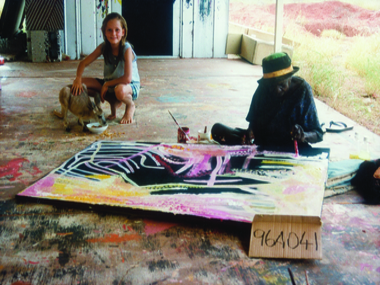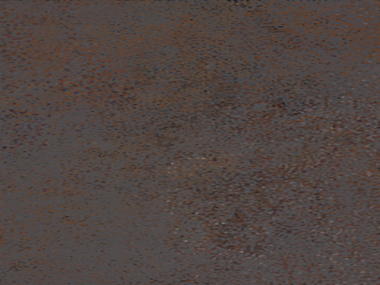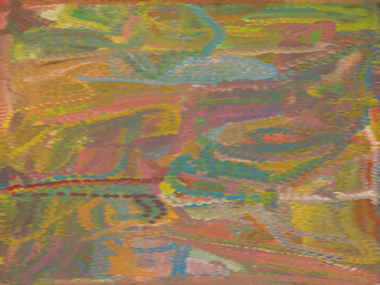EMILY ON SALE

Emily Kngwarreye painting at the Holts' place, watched by the young Annabel Holt
Posted by Jeremy Eccles | 18.03.13
Gallery: Deutscher and Hackett Melbourne
Dates:
14.03.13
: 27.03.13
It's a fascinating time for the reputation of the great Emily Kngwarreye. Some time in May a whole museum is opening in Melbourne dedicated to her works from the collection of Hank Ebes, a major dealer during the later years of the artist's brief 7 year painting career. And this month (March), 20 works are up for sale at auctioneers Deutscher & Hackett – again in Melbourne – all from the collection of Donald and Janet Holt.
The Holts used to be contentious figures. In the feeding frenzy that accompanied the realisation that Kngwarreye's works had a universal appeal and a comparatively simple spirituality that the earlier works coming out of Papunya and Yuendemu had lacked, many a dealer drove the 240 kms from Alice Springs north east out to Utopia Station in the hope of picking up a bargain or two. Some lumped the Holts in with this motley crew. In fact, they lived next door to Utopia on Delmore Downs, they both had backgrounds in the arts – Janet briefly at Papunya Tula, and Don collecting traditional weapons, being related to Chandler Coventry and his gallery in Sydney, and having known Emily from his childhood. As a result, the artist spent many hours protected from the world painting on the Holt verandah.
As many of her paintings therefore passed through the Holts' hands as were dealt with by Rodney Gooch at CAAMA in Alice Springs, at the self-referential Utopia Gallery in Sydney or at Gabrielle Pizzi's Gallery in Melbourne. However, it should be made clear that the assertion in the D&H catalogue by the Holts' daughter Annabel that her parents were the first to offer Emily canvas to paint on is just not true. That was certainly the inspiration of Rodney Gooch in the so-called 'A Summer Project' over the summer of 1988/9. Gooch had earlier tapped into the Utopia women's enthusiasm for batik work in 'Utopia – A Picture Story' – all bought by Robert Holmes a Court. But he'd realised that some artists – especially Emily – would be more adept at painting, and had delivered eighty 2 foot by 3 foot canvases to see what emerged.
The cover work for the resulting exhibition in Sydney was Emily's Emu Woman, a work of instinctive painterly qualities, while many others in that show clung to the basics of their batik experience. Again the whole show went into the Holmes a Court Collection including such names as Ada Bird Petyarre, Kathleen Petyarre, Nancy Kunoth Petyarre, Angelina Pwerle – but not, strangely, the subsequently prolific Gloria Petyarre.
But much else that Annabel Holt writes is a beautifully personal insight into the symbiotic relationship between pastoralists in the semi-desert and their resident Aborigines, in which the young Holt girl could spend hours watching Emily and Lily Sandover (her tribal sister) paint, supplying tea as they sang their stories into paint, and being invited to ceremonies that introduced her to the female power that resided in such elders.
The 20 works that were on show at D&H in Sydney (soon in Melbourne) cover Kngwarreye's career from 1989 to 1996. Not all of the artist's many different styles are represented, but there's strong coverage of the early years when yam roots or emu tracks were covered by a haze of dotting, leading up to the 1992 Summer (Atnulyere) Yams which the Holts believe was the last appearance of that “linear underlay” in Emily's oeuvre. There are various patterns of Awelye – the body painting lines that could be straight or curved, and there's a fascinating analysis of the structural differences in two similar black on white curved versions.
There are too many 'Colour-saturated' works for my taste – where it seems to me that Emily's impeccable colour-sense went awry, though many a connoisseur of non-Indigenous art find these the most exciting of her works. And Annabel Holt justifies them as "reaching for something new in every painting".
And there are three oddities – distinctive works like an early batik impression, a late red work on a black background that is claimed to reflect the evening light when the Yam ceremony commenced, and the marvellously moody Mourning Story in greys and browns with just the occasional white dot penetrating the gloom.
Did Kngwarreye call the work Mourning Story? Or another Spirited Desert? Or Coloured Abundance? I suspect not, and I'm not comfortable with such marketing ploys. They're pretty much a match for the use of words such as Minimalism, Abstract Expressionism and Colourism borrowed from the Western art lexicon, and quite irrelevant to Emily's instinctive intentions in covering her canvases.
There may have been no art centre at Utopia to religiously record the meanings behind her paintings, but the Holts' notes in the D&H catalogue suggest valuable sharing of information between artist and her dealers. And Doug Hall, the former Director of the Queensland Art Gallery caps off this concentrated experience by insisting that “Emily is critical to the understanding that Aboriginal culture is viewed as an expression of what represents modern Australia”.
The D&H auction takes place on 27 March in Melbourne, with 80 other Indigenous works on offer as well.
URL: www.deutscherandhackett.com
Share this:
»  del.icio.us
»
del.icio.us
»  Digg it
»
Digg it
»  reddit
»
reddit
»  Google
»
Google
»  StumbleUpon
»
StumbleUpon
»  Technorati
»
Technorati
»  Facebook
Facebook
Contact Details
Gallery: Deutscher and Hackett Melbourne
Email: info@deutscherandhackett.com
Telephone: +61 3 9865 6333
Address: 105 Commercial Road South Yarra Melbourne 3141 VIC
Gallery: Deutscher and Hackett Melbourne
Email: info@deutscherandhackett.com
Telephone: +61 3 9865 6333
Address: 105 Commercial Road South Yarra Melbourne 3141 VIC

Emily's unusual 'Mourning Story' from 1989. Synthetic polymer paint on canvas, 122 x 90 cms

'Coloured Abundance' 1993 by Emily Kngwarreye - one of her Colourist paintings given a fresh title
Where is the exhibition?
Further Research
Gallery: Deutscher and Hackett Melbourne
Artists: Ada Bird Petyarre | Angelina Pwerle | Emily Kngwarreye | Gloria Petyarre | Kathleen Petyarre | Lily Sandover | Nancy Kunoth Petyarre
News Tags: art auction | Deutscher & Hackett | Donald Holt | Emily Kngwarreye | Rodney Gooch | Utopia Station
News Categories: Auction | Australia | Event | Exhibition | Feature | Industry
Exhibition Archive
- 10.10.17 | TARNANTHI 2017
- 11.08.17 | Natsiaas 2017
- 20.07.17 | APY ART DOMINATES THE WYNNE
- 17.07.17 | Anangu Artist Wins $100,000 Prize
- 14.07.17 | The End of AAMU
- 11.07.17 | ART ACROSS THE COUNTRY
- 11.07.17 | TARNANTHI IN OCTOBER
- 05.07.17 | TJUNGUṈUTJA - from having come together
- 13.06.17 | Ghost-Nets Straddle the World
- 07.06.17 | Grayson Perry Going Indigenous?
- 05.06.17 | Barks Bigger than Ben Hur
- 27.05.17 | NGA QUINQUENNIAL 2017
- 21.05.17 | Blak Douglas Finds Home at the NGA
- 21.05.17 | BRIAN ROBINSON WINS HAZELHURST WOP
- 18.05.17 | PARRTJIMA 2.0
Advertising

